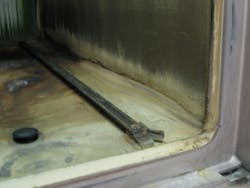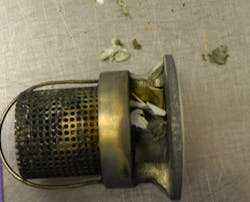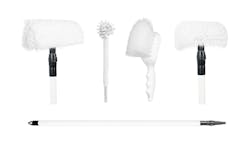Q
“We do some daily tasks to keep our sterilizer clean. We are now being asked to clean the sterilizers (chamber) with brushes and a chemical. I thought that was the responsibility of the sterilizer company. What are your thoughts?”
A
First, we need to understand that sterilizers come in many sizes and types—from tabletops to floor loading—and all of them require some type of inspection and maintenance (i.e., daily, weekly, quarterly, and yearly). This can be performed by many different people, depending on the difficulty and training needed, to accomplish the desired task. In this circumstance, we are talking about a clean sterilizer.
From the wording of your question, I would consider this routine care, and your management team wants to add another task (duty) to your present work responsibilities concerning the care of your sterilizer.
This type of activity (cleaning the sterilizer wall/chamber) would be found in your specific sterilizer’s user manual/instructions for use (IFU). It might list daily activities, such as a) wiping the seal, b) inspecting for cracks or damage to the seal, c) looking for staining in the chamber, d) cleaning the drains, and e) other tasks. Some of these tasks might be done at a different frequency. The IFU should state who (i.e., the user or someone else) is responsible for these tasks. It could also include daily inspection of the sterilization racks or carts. All tasks, regardless of who performs them, should be documented as having been performed.
Now, concerning the second part of your question. In 1975, my first position was within Central Sterile as a sterilization orderly. I learned to clean the inside of the sterilizer chamber with a good instrument cleaner, then rinsed with distilled water, and dried the chamber with a non-linting cloth. We eventually made our own cleaning solution consisting of one-part vinegar to one-part water followed by a distilled water rinse. It was effective.
What you also need to understand is that the Association for the Advancement of Medical Instrumentation (AAMI) recently released AMENDMENT 3 (A.3:2020) to Section 12.4 of ANSI/AAMI ST79:2017 Comprehensive guide to steam sterilization and sterility assurance in healthcare facilities. If you have not already done so, my suggestion is to purchase and review it, as it will be very helpful.
AMENDMENT 3 deals with the topic Modification of content pertaining to frequency of cleaning for routine care of sterilizers for sterile processing areas in healthcare facilities. The proper care and maintenance of a steam sterilization apparatus is a crucial factor in providing appropriate instrument care. It also ensures the safe and effective operation of any type of steam sterilizing apparatus, sterilizers, carts, and racks, which should be cleaned frequently (ideally daily, but at least weekly).
When cleaning a sterilizer, it is important to understand the composition of the sterilizer’s wall/chamber. Today, stainless steel is what most everyone uses, but older sterilizers were made of cold-rolled steel with a nickel clad. Knowing helps if you use chemical versus a bead-blasting method for cleaning.
You asked for my opinion on cleaning the sterilizer chamber. I do not have an issue with medical device reprocessing staff doing routine cleaning of their sterilizer wall/chamber (if properly trained) and with the proper type of supplies. Based on my observations, departments that do not make cleaning part of their routine program have some very dirty walls/chambers. The result is that many spend unnecessary money with vendors for a “deep cleaning,” when they could have avoided the mess with consistent routine cleaning.
If you do start cleaning your sterilizer, here are some basic steps to think about as you develop your policy:
- Make sure you are properly trained on your specific sterilizer(s).
- Some departments have different makes and types.
- Ensure you have correct supplies.
- Turn off the sterilizer and cool to room temperature.
- Clean the drain screens.
- Place an out of order/service sign on the sterilizer while you are cleaning.
- Document your activity per policy.
- Having a clean sterilizer wall/chamber is important. An inside clean sterilizer may lead to less problems; makes it easier to identify staining (an early warning sign of possible steam quality issues) if it starts to appear; and an early resolution of issues.
As I say, “Keep it clean.” In this instance, it is the sterilizer’s walls/chambers. Just like anything else, if you take care of it from the start, then it will last a long time.
See pictures below of bad sterilizer walls and various types of brushes you can use for cleaning.
References
1. V. Mueller. (1990). Atlas of Surgical Instrument Care: A comprehensive program for cleaning and sterilization of surgical instruments. Baxter Healthcare Corporation.
2. STERIS. (1998, March 26). Manual STERIS Sterilizer Service and Maintenance Procedures; Amsco EAGLE SERIES 3000 Gravity and Vacamatic Sterilizers. (V. 1; P-129359-452).
3. AAMI (2020). ANSI/AAMI ST79:2017/A3:2020: Comprehensive guide to steam sterilization and sterility assurance in health care facilities, AMENDMENT A.3 Modification of content pertaining to frequency of cleaning for routine care of sterilizers for sterile processing areas in healthcare facilities [Sec. 12.4 Routine Care of Sterilizers].) (2020). Arlington, VA: Association for the Advancement of Medical Instrumentation.
About the Author

Stephen M. Kovach
Stephen M Kovach, BS, CFER, started in the medical field in 1975 as a sterilization orderly and has worked in many positions within the Healthcare Industry. He presently is Clinical Educator Emeritus at Healthmark, A Getinge company.




